James Family of Ireland¶
The James Family of Ireland comes to Canada (1816-1850)
Part 1: The Story Begins 1670-1735¶
Our story of the JAMES family of Ireland and later Canada is said by several family sources to begin at or around the time when William III defeated King James at the Battle of the Boyne in 1690. Family lore has it that three JAMES brothers, EDWARD, JOHN and WILLIAM were part of William’s army and in lieu of payment of military wages received land in “Carlow, Wexford and near Dublin.” If they were young military men about 20 years of age in 1690, we can date their births at about 1670.

But how did their descendants come to be in one place, half way round the world, a century and a half later? This is the story I hope to tell here. I will leave it to others who are better at it than I to tell the stories of what happened after they arrived (to a great extent) in Lanark County, Upper Canada (or the Bathhurst District as it was called then), starting in 1816. It was the result of the same strategy used by the British Empire to maintain its hegemony amidst non-British neighbors - plantation - the bringing in of settlers who could be expected to remain loyal to the British crown and to fight for it if required. In 1816, in the wake of Ireland’s highly divisive Rebellion of 1798 many loyalist Irish were ceasing to see a future for themselves in Ireland.
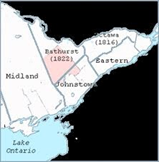
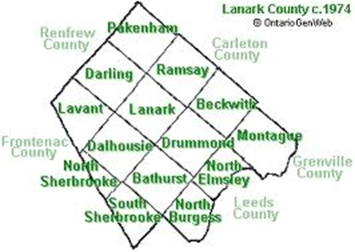
Why did they end up together in Bathurst (later named Lanark) and why not all in one locale? The answer is that they did NOT all end up in Lanark County (some, as we have already seen, emigrated to America, not Canada) but many of them did. This once proud and sometime moderately rich landowner JAMES family had sunk to the point of needing the assistance of the British government who were offering, by about 1816-17 assisted passage and land grants on the other side of the ocean. Great Britain, still smarting from a difficult undermanned victory over the Americans in the War of 1812 had adopted a policy of filling out lands which were one county removed from the border with the U.S. with settlers with some military experience, who could be expected to form loyal militias in case of future attacks from south of the border. So, where they located was determined by which township was being filled at the time.
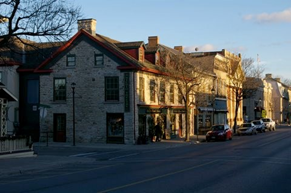
Historic Perth, still somewhat as it looked in 1820
Lanark County with the exception of the military depot at Perth was a primeval forest covering land which was so rocky that it would prove to be largely unsuitable for farming. But it was available, and it was being allotted, township by township as it was surveyed, to shiploads of Scottish and Irish emigrants. The setters, with their passage either paid by the British government or in some cases by the landowner Fitzwilliam family in Wicklow, were assigned plots of 100 acres for each male who had reached the age of 18 and given the rudiments of building a home and setting up a workable farm wuth the grant becoming permanent if they cleared a certain portion of the land within the first four years.
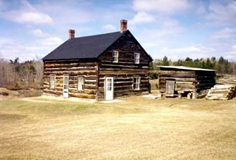
Most houses were log-built and simple, some of which even survive to this day as occupiable dwellings. But this was a carving of civilization out of the primal forest, and at the time there were few roads, so traffic from place to place was largely on foot other than to the few farmers who owned horses. As settlers arrived, largely after an eight week passage on a less-than-hospitable sailing ship, landing at Quebec City, they boarded a steamship which brought them up the St. Lawrence River to Elizabethtown (now Brockville) where they embarked on a journey, on foot, northward to discover where in the forest they would be assigned a place.
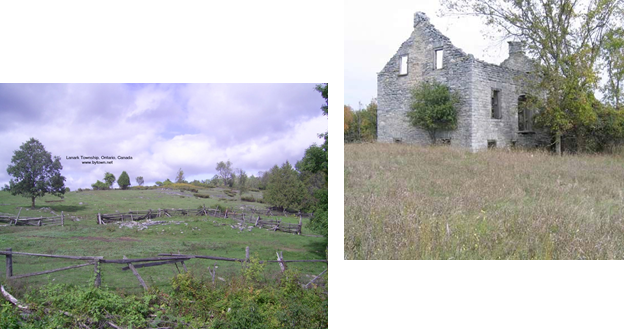
Some were better heeled than others (like the family of William James Sr. 1786-1843 who had married into the prosperous Chamney family in Ireland) and could afford to build stone houses, but land was not handed out in a preferential way. One got what was available.
The soil was very rocky, not at all like the lush farmlands of Wicklow, Wexford and Carlow, an anomaly which led to the next generation tending to move further west in Ontario. The removal of stones fell often to the younger generation, paradoxically leading to James Naismith’s invention of the game of basketball in this area, based on the youthful rock-removal game of Duck On The Rock. But I digress!
The first JAMES setter to arrive in Lanark appears to have been Edward James (1757-1834) a yeoman cavalryman (from Capt. Hawtrey White’s Ballaghkeen Cavalry) from Knockadawk in Wexford. He and his large family were given the upwards of five hundred acres on the first two Concessions of Dalhousie Township, near Perth. The next large influx of JAMES settlers, though there were dribs and drabs in the meantime to nearby Beckwith Twp., were the family of William James Senior (1786- ) who arrived with several other families from Aghold Parish in Wicklow in 1820. Family lore has it that much of his large family stayed with their Drummond Twp. cousins until a home was built for them.
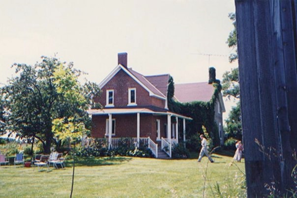
Eventually this home would be the relatively upscale residence (see above) which remains in the James family to this day. At Lanark Twp. Con. 12 Lot 12 SW. We must keep in mind, that at the time the land was being painstakingly carved out of the forest. It was clearly not lush Ireland!
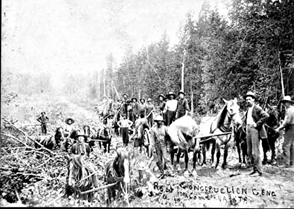
While many of the settlers has been poor under-tenants in Ireland, at least some of the JAMES family were petty gentry for the most part. Whether they had owned land or rented in The Old Country, here they were equals. According to author Carol Bennett McQuaig’s Leinster to Lanark there were somewhere between 10 and 16 about James families who settled in Lanark in this early era. While they were not all from the same branch of the family, the more one looks at them individually, the more one realizes that the majority of them had the same Cromwellian roots, the same Protestant, Church of Ireland (Anglican) religion, the same Loyal Orange Lodge affiliations, and once in Ontario, the same Conservative Party leanings. I will return to Carol’s book later. it has been of invaluable help in keeping track of the JAMES family in Lanark, and, in the end, I was able to use it to follow up some loose ends created by there being scanty record-keeping in the early days of settlement much as there was hit-and-miss record keeping in the areas from which the family came. In thanking Carol, I must also thank Eileen James and her father Des James, who were responsible for collecting much of the early documentation that got me started. Without further adieu, let’s turn to the James family of Ireland...
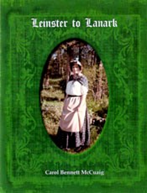
James Family at Ballyknocken, Carlow¶
The first official mention of their origins among the documents in my possession is a rare copy of the 1735-6 will of JOHN JAMES of Ballyknocken, Carlow (see map of Carlow below 1798) indicating that his forebears were from “STOWERBRIDGE and WONGBY in Worcestershire”, his maternal grandfather being one Thomas Devell. I wasn’t able to locate “WONGBY” but did locate several french-origin Devell families, including some on Worcestershire believed to date back to the time of William the Conquerer. It was also suggested by researcher Dermot James, that a separate JAMES family in County Offally were related to Thomas JAMES, the British explorer who discovered Canada’s JAMES BAY. Thomas’ son, John James served in Cromwell’s army. Descendants later appeared in Dublin as successful merchants. One of them Alderman (Sir) John Kingston James was Lord Mayor in 1820-1 and again in 1840-1.
While the family seat of many of the James families of record was built at Paulville or Tankardstown northeast of Tullow in Carlow clearly there was another seat at Carnew in Wicklow and the nearby estate of Urelands, and another in the Ballycanew-Knockadawk region of Wexford, there were many parishes and townlands in Carlow which were home to JAMES families. These will also be the hardest to shape into a James family tree, as many of the parishes lack records from the eighteenth century. The map below will show most of the parishes (and/or townlands) where James families resided.
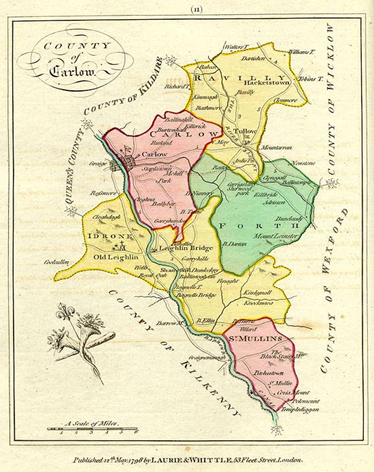
JAMES, THOMAS, English navigator and explorer who, in 1631–32, explored the west coast of Hudson Bay and James Bay in an attempt to find a northwest passage; b. 1593?; d. 1635?
Little is known of James’s ancestry and early life. Available evidence indicates that he was a son of Thomas James, mayor of Bristol in 1605 and 1614, and that before he turned to the sea he was a Bristol barrister, probably wealthy.
James’s opportunity to head a northwest passage expedition arose through the commercial rivalry between London and Bristol merchants. Capt. Luke Fox had persuaded a group of London merchants to support him in a search for a northwest passage. The Bristol Society of Merchant Venturers determined to send a similar expedition, for they feared the London merchants might secure a monopoly of whatever markets or trade Fox might discover. Capt. James represented the Bristol merchants at court and obtained for them from Charles I a promise of equal rights and privileges in whatever discoveries either expedition might make, in proportion to each city’s investment in the dual venture. On 3 May 1631, James sailed from Bristol in a 70-ton ship, named Henrietta Maria after England’s queen, with a crew of 22 men. He took no one who had ever sailed on a northern voyage for fear that opinion based on previous experience might conflict with or diminish his own authority. On 5 June the ship entered the ice near Davis Strait and there James and his men began an almost uninterrupted series of harrowing adventures. Reference: http://www.biographi.ca/009004-119.01-e.php?&id_nbr=355{target=_blank}

The area purchased by JOHN JAMES at Ballyknocken (Townland) from the Bagenal family (descendants of Sir Nicholas Bagenal, knight, Marshall of Queen Elizabeth I’s armies - died 1575) at Dunleckney, Carlow and later willed to his son THOMAS JAMES, was owned by the Bagenal family, and was mentioned in the 1746/7 edition of the Dublin Journal (below) in the early years of of Beauchamp Bagenal (1735- 1802) the famous duelist and rake’ - godfather of ill-fated rebel general Beauchamp Bagenal Harvey who, in turn, was related by marriage to JAMES family member Col. RALPH JAMES (see below).
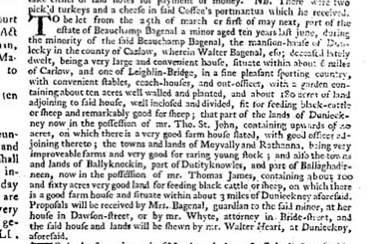
In the accompanying map (above), one can also see the Townland of Ballaghadirneen which was acquired by JOHN JAMES, and willed to his son THOMAS JAMES in 1735 (see copy of this will below) and which takes in the location of the home of a later THOMAS JAMES (b.c. 1770) and FRANCES WELLWOOD (b.c. 1770) at Carrig Beg in the 1790’s. Beauchamp Bagenal (1735-1802) was the son of Walter Bagenal and Eleanor Beauchamp.
He is described in John Ryan’s History and Antiquities of the County of Carlow (1833) “ He was a man of singular character. It has been said of him that he had the eccentricity of the Bagenals, the parsimony of the Beauchamps, and the pride of the Matthews (his grandmother’s maiden name.) He was the great spirit, and fought in his time as we believe, and half a score of tools. The churchyard of Killinane was a favorite spot with him on these belligerent occasions; where, being lamed from an accident, he always maintained his perpendicular by resting against one of the tombstones; and thus received the fire of his adversary. In fact Bagenal had the fierce passion of the “fire eating” Irish squires of that day. (He was) at all times a high patriot.” From the internet “wiki” on him we learn -“Bagenal gained a reputation as a hell raiser and serial heartbreaker, and was reportedly described as the handsomest man in Ireland. According to Jonah Barrington, on his Grand Tour, Bagenal: fought a prince, jilted a princess, intoxicated the Doge of Venice, carried off a duchess from Madrid, scaled the walls of a convent in Lisbon and fought a duel in Paris, The jilted Princess referred to above was Charlotte of Mecklenburg-Strelitz, afterwards married to George III of England
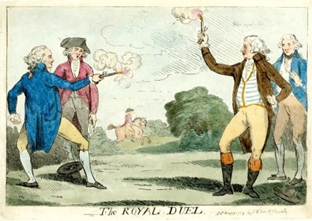
At his home, Dunleckney (seen below as it was refurbished in the mid 1800’s) Muine Bheag (Bagenalstown), County Carlow, he earned the nickname "King" Bagenal based on his lavish entertaining and the autocratic manner with which he ran what was virtually a court. Meals were "primarily drinking bouts. At table, he kept a brace of duelling pistols handy, one for tapping the barrel of claret, the other for dealing with any of his guests who failed to drink enough to send him reeling from the table. Dinner was followed by compulsory all night revels."
Bagenal was less violent than his later reputation. There is no proof that he shot all, or even many, of his guests. He fought as few as a dozen duels, a derisory number compared to the great duellists of his day. One of the twelve was against his own cousin, Bagenal Harvey. Harvey fired first, but missed, to Bagenal's delight. "You damn you villain? Do you know you had like to kill your own godfather? Go back to Dunleckney, you dog, and have a good breakfast ready for us. I only wanted to see if you were stout."
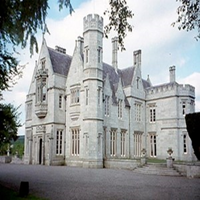
WILL (1735) “JOHN JAMES of Ballyknocken, Carlow¶
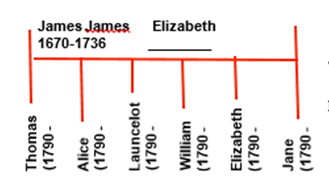
-
to wife, Elizabeth James, 1/2 the house and James furniture at Ballyknocken, a grazing of 5 cows and 10 Pounds, yearly for all her life.
-
to William James son to Edward, deceased, 1 shilling.
-
to daughter Alice Cotton, 1 shilling
-
to sons Launcelot James and William James, all my estate in England about STOWERBRIDGE and Wongby in Worcestershire, which descended to me from my grandfather, Thomas Devell, I being his next heir male after the death of his son Thomas Devell, they paying my daughters Elizabeth James and James James 200 pounds each,
-
An account to be settled with Edward Chamney and Joseph Chamney *(these two men will be seen later)*
-
House and lands at Ballyknocken, and Bally-Timin and their subdenominations to son, THOMAS JAMES.
-
Edward Cooper of Scragh and Samuel Watson of Killconor to be repaid what they paid for Testator for 1/2 the lease of Ballyknockan. “
NOTES: It is interesting that there is an association with the CHAMNEY family, as later in 1804, William JAMES married Elizabeth Chamney in Tullow. The Chamney family and their in-laws the Bacon family had come from England to Shillelagh to create an iron works, and were enormously successful, mining 52 or more locations in Wicklow, Carlow and Wexford.
The Chamney suname appears often in the JAMES family trees. (For this reason I am referencing it here (and will re-reference it later) There is a tradition in the family that the first Chamney was one of the Commissioners sent to Ireland in the seventeenth century to buy oak for the British navy, that he was a scion of the noble House of Cholmondeley, that while in Ireland he fell in love with and married the daughter of Bacon, the owner of the ironworks, who had become a millionaire. His family being displeased at the marriage, he changed his name to Chamney. A note in the article quoted above, p. 306, says " that his real name and lineage are given on his tomb in Carnew churchyard," but this inscription is now obliterated. Some of the Chamney family are mentioned with praise in Maxwell's History of the Irish Rebellion, Chap. XVI. Joseph Chamney, granduncle of Rev. Joseph Chamney, was a Captain of the Coolattin Yeomanry Corps, and fell in an action with the rebels near his own house at Ballyrahine ( or sometimes spelled Ballyraheen on July 2, 1798.
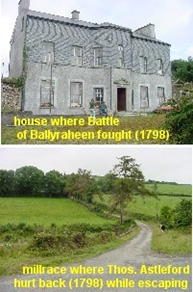
His brother, Thomas Chamney, (grandfather, of Rev. Joseph Chamney), who was a Lieutenant in the Corps, however, with 60 infantry successfully defended Captain Chamney 'a house. I am informed that it hears traces of the assault to this day. The rebels lost about 150 men. Cruikshank has given an illustration of the attack in Maxwell's History. There is a monument in Carnew Church to Captain Chamney and his nephew, who was also killed in the action.
EDWARD JAMES (1670-? 1734 )of Ballycanew/ Kiltrisk¶
The EDWARD JAMES of his presumed brother JOHN JAMES Will “appears to have had” at least one additional son (in addition to the dispossessed WILLIAM JAMES of John James’ will), JOHN JAMES before his death in 1734 at Balleycanew, Wexford. I say presumed death, because the name Edward James is common enough that it is hard to say for sure which one was whom. However, this one is promising, appearing in the partial BMD records of St. Mogue’s C. of I in Ballycanew, Wexford, (Godkin researcher, Wally McMahon)
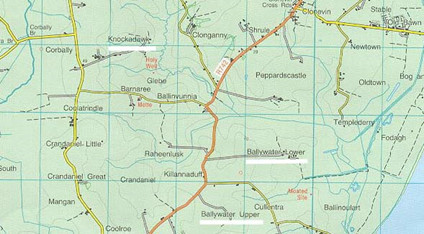
Added to this the Tennison-Groves records as lists a marriage: JOHN JAMES to JUDITH TUDOR BEATTY in 1721 (the Beatty family appears at Balleycamew). From the BMD records of St. Mogue’s Edward James died at Ballycanew 10 February1734.Presumably Edward was married or otherwise had issue as we then see on the same page: (Record largely destroyed) son to Edward James died 7 March 1734. Edward’s presumed brother John’s wife Mary’s will (seen below) also mentions a son, William JAMES. A William JAMES is listed as a vestryman at St. Mogues in 1786, 1799-1801 and in 1813. (Vestry Book PDF file)

Arthur Tenison-Groves recorded the following marriage:
JOHN JAMES married MARY GOFFE ( -1758) 22 August 1753.
By 1758 she was presumably widowed and made a will of her own (also from Tenison-Groves) (proved 16 January 1760) willing....
-
all her property to her son JOHN JAMES of Knockadawk
-
small legacies to ANN JAMES and BETTY JAMES and daughters Ann Marky (of Kilpatrick) and Elizabeth Sloan (alias JAMES)
-
1 shilling to step-son WILLIAM JAMES
(This will leaves one slightly confused but with a lot of information at the same time. It certainly suggests that this was not JOHN JAMES first marriage - he had issue, at least, WILLIAM and ELIZABETH (who was old enough to be married.) It also suggests she had issue from a previous marriage (Ann Marky - who was also old enough to marry.) It is also interesting that sons, Edward, Henry and Thomas are not mentioned (but perhaps there is another will , by JOHN, where they are mentioned.)
The usual Protestant Irish use of the 1 shilling legacy ( called “the angry penny” ) was to dispossess a family member who, against the will of his relatives has marred a Catholic wife. William James, however, was a Church of Ireland vestryman at St. Mogues, so this cannot be the reason for the 1 shilling legacy.
Conjecture: John James Sr. has recently died leaving his property at Knockadawk to his wife and his stepson William, or has died intestate (with the same result.) William James may have had prior claim to the estate as oldest son, but as an adult with his own means, agrees to be removed as an inheritor.
EDWARD JAMES (1757-1835), of Corbally, Knockadawk (116 acres bounded on the east by the high road to Wexford, on the west by the River Owen, on the south by Coolbrindle, on the north by Ballart) son of JOHN JAMES and Mary Goffe, married JANE GODKIN (parents HENRY GODKIN and ? BARBARA WEBSTER), Wexford 3 November 1781. Edward had two brothers, Henry and Thomas James, making it difficult to fit their births in before MARY’s death in 1759. In many ways this semi-conjecture fits - and quite well. In other ways it causes difficulty.
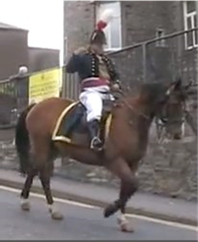
EDWARD JAMES was a 31 yr. old prosperous farmer at Knockadawk, and a member of Captain Hawtrey White’s, infamous yeoman Ballaghkeen Cavalry at the time of the Rebellion of 1798.
Thirty-eight different regiments and battalions of the Irish Militia were formed since their inception in 1793. Their uniforms consisted of red military coats, white breeches and black gaiters and black shoes. Various facing colours were used for the different regiments such as yellow (the most popular), blue, white, black and green. Different forms of black felt three cornered hats (tricorns) and bicorns were also worn. Regiments colours were carried into battle and the King's Colour (the first Union flag) contained the crosses of St Andrew and St George. Weapons included the six-pounder cannon, swords, muskets and pistols Corps of yeomanry ( units like the Ballaghkeen Cavalry, by local Magistrates and Justices of the Peace) were first raised in 1796 also wore red coats while the cavalry troopers wore dark blue jackets, with white breeches, black boots. Capt. Hawtrey White would have been uniformed as seen above ( a picture from a 1798 re-enactment in 2012.)

EDWARD JAMES’ farm near Peppardscastle, Wexford (see map) was destroyed by “the Rebels”, for which he received compensation by the British government. The loyalist yeomen were known to be cruelly suppressive of the Catholic majority’s attempts to gain freedom from repressive laws and suppressive attempts to prevent them from education and land ownership, Captain Hawtrey White, along with Wexford magistrate, Hunter Gowan, were some of the most feared and most hated Protestants at this time, so, though finishing on the winning side of the Rebellion, loyalist farmers like Edward JAMES who had fought in the Rebellion began to look elsewhere to house their families over the long run, and accepted invitations to get land in Canada when the British made offers in 1817 Edward James (1757-1835) arrived in Drummond Township in 1817, traveling on the ship Jane, and settling 500 acres on Drummond Concessions 1 and 2 with nine children - Mary b. 1782, John b. 1786, William. b. 1788, Thomas b. 1793, Edward b. 1794, Barbara b. 1798, Benjamin b. 1799, Henry b. 1802, Anne b. 1812. Family Tree Canada:
Vestry Records St. Mogue’s Ballycanew:1760-1819 Vestry Book PDF file {target=_blank}
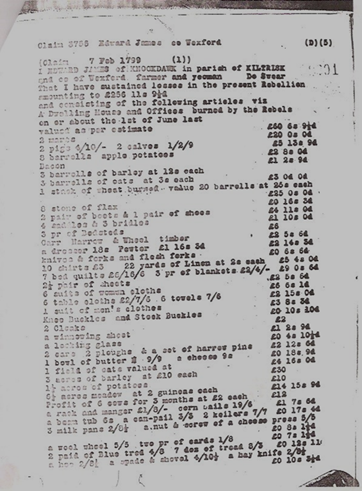
Edward submitted a claim for compensation for his losses in the Rebellin. He stated in his claim that he was forced to move his family to Gorey, aNd then to Wicklow (where presumably they stayed with William James Sr. who later (1804) married Elizabeth Chamney.
Above is the list of items submitted for compensation, as it appears in the Tennison-Groves report.
EDWARD JAMES received the amount he requested, apparently rebuilt his farm, and later transferred it to his bother, Henry before leaving for Canada in 1816.
EDWARD was the first of the JAMES clan who relocate, and the family story is that Edward and Jane left their younger children behind and sent for them later.
Brothers, John, Henry and Thomas JAMES did not relocate to Canada.
At least one other member of the Ballaghkeen Cavalry, John Greenly or Greenley, also from Knckadawk, emigrated as well to Drummond Twp. Dorothy Greenley’s 1818 letter to her daughter is rather revealing of conditions in the far reaches of the new colony.